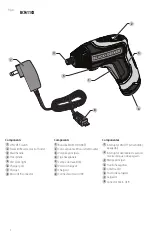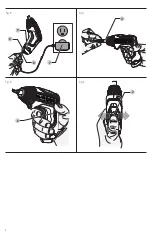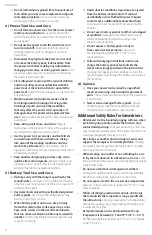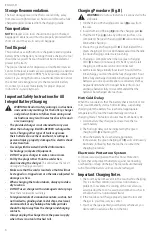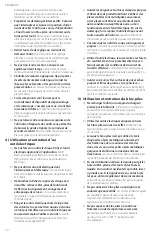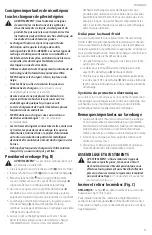
English
6
Charging Procedure (Fig. B)
WARNING:
Do not use tool while it is connected to the
USB cable.
1. Pull the micro USB charging port cover
14
away from
the tool.
2. Insert the micro USB plug
12
into the charging port
6
.
3. Plug the USB plug
8
into any USB port (such as on a
computer). The green charging LED
9
will continuously
blink while charging.
4. Ensure the green charging LED
9
is illuminated. If the
green charging LED is not illuminated, adjust tool handle
to ensure charging contacts are touching.
5. Charging is complete when the five green charging
LEDs
9
remains continuously ON. Battery can be left
charging or USB cable can be disconnnected.
6. Let the tool charge initially for at least 1 hour. After the
initial charge, your tool should be fully charged in 1 hour
from a fully discharged condition. Recharge discharged
batteries as soon as possible after use or battery life may
be greatly diminished. For longest battery life, do not
discharge batteries fully. It is recommended that the
batteries be recharged after each use.
Hot/Cold Delay
When the tool detects that the battery that is too hot or too
cold, it automatically starts a hot/cold delay, suspending
charging until the battery has reached an appropriate
temperature. The tool then automatically switches to
charging mode. This feature ensures maximum battery life.
1. A cold battery may charge at a slower rate than a
warm battery.
2. The hot/cold delay will be indicated by the green
charging LED
9
remaining OFF.
3. Once the battery has reached an appropriate
temperature, the green charging LED
9
will continuously
illuminate, indicating that the tool has resumed the
charging procedure.
Electronic Protection System
Li-Ion tools are designed with an Electronic Protection
System that will protect the battery against overloading,
overheating or deep discharge. The tool will automatically
turn off and the battery will need to be recharged.
Important Charging Notes
1. The tool may become warm to the touch while charging.
This is a normal condition, and does not indicate a
problem. To facilitate the cooling of the tool after use,
avoid placing the tool in a warm environment such as in
a metal shed or an uninsulated trailer.
2. If the tool does not charge properly, take the tool and
charger to your local service center.
3. You may charge a partially used battery whenever you
desire with no adverse effect on the tool.
Important Safety Instructions for All
Integral Battery Charging
WARNING: Read all safety warnings, instructions,
and cautionary markings for the battery, charger
and product. Failure to follow the warnings and
instructions may result in electric shock, fire and/
or serious injury.
•
The provided charger is not intended for any uses
other than charging BLACK+DECKER rechargeable
tools. Charging other types of tools may cause
their batteries to overheat and burst, resulting in
personal injury, property damage, fire, electric shock
or electrocution.
•
Use only with the Listed/Certified Information
Technology (computer) Equipment.
•
DO NOT expose charger to water, rain or snow.
•
Pull by the plugs rather than the cord when
disconnecting the charger.
This will reduce the risk of
damage to the plugs and cord.
•
Make sure that the cord is located so that it will not
be stepped on, tripped over or otherwise subjected to
damage or stress.
•
When charging the tool outdoors, always provide a
dry location.
•
DO NOT use a charger with a damaged cord or plugs
.
Have them replaced immediately.
•
Foreign materials of a conductive nature, such as, but
not limited to, grinding dust, metal chips, steel wool,
aluminum foil or any buildup of metallic particles
should be kept away from the charger and charging
contacts.
•
Always unplug the charger from the power supply
when there is no tool attached to it.
Storage Recommendations
The best storage place is one that is cool and dry, away
from direct sunlight and excess heat or cold. Store the fully
charged tool disconnected from the charging cradle.
Transportation
nOTE:
Integral Li-ion tools should not be put in checked
baggage on airplanes and must be properly protected from
short circuits if they are in carry-on baggage.
Tool Disposal
This product uses a lithium-ion rechargeable and recyclable
battery. When the battery no longer holds a charge, the tool
should be recycled. The tool should not be incinerated or
placed in the trash.
The tool can be taken for disposal to an Authorized Service
Center. Some local retailers are also participating in a national
recycling program (refer to RBRC®). Call your local retailer for
details. If you bring the tool to an Authorized Service Center,
the Center will arrange to recycle the tool and its battery.
Or, contact your local municipality for proper disposal
instructions in your city/town.
Summary of Contents for BCF611CB
Page 4: ...2 Fig B Fig C Fig D Fig E 7 4 2 6 3 8 9 ...
Page 25: ...23 ...
Page 26: ...24 ...
Page 27: ...25 ...
Page 28: ...07 20 Part No N748171 Black Decker U S Inc 701 East Joppa Road Towson MD 21286 Copyright 2020 ...



